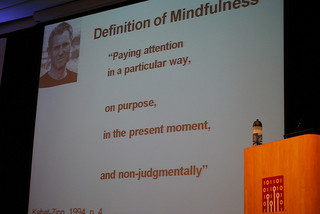|
|
|
Thursday, December 5th, 2013

Entrepreneurs are in love with their technology, whether it’s software, hardware, services, food, etc.
Doesn’t matter, given their druthers they would much prefer to tell you why the technology is so awesome and how it will change the world—or at least a part of it.
That’s OK when talking to another techie, but investors are far more interested in the market.
And, other than cutting-edge outliers, the market doesn’t really give a damn about the technology.
The market is strictly WIIFM or, as Asana cofounder Justin Rosenstein puts it,
“Ultimately everything else we do is essentially a means toward an end of providing the user with some experience. We are really constantly grounding the whole company in that empathy of realizing that all the work you’re doing is a means to an end in service of and dedication to other people, an act of service to help others.”
Asana’s numbers are impressive.
It was founded in 2008 (think Recession), exited beta in 2011 (three years), has over 50 employees and is used by hundreds of thousands of teams from the likes of Twitter, Foursquare, LinkedIn and dozens of others.
It has a valuation north of $300 million.
Asana accomplished all this with just $38.5 million in venture funding—a tiny number by today’s standards.
Read the interview of Rosenstein and cofounder Dustin Moskovitz and their use of mindfulness to create a culture that focused on customers.
Then evaluate the focus of your own culture.
Because no matter how cool your technology, it’s worthless if people don’t/won’t buy it.
Flickr image credit: cambodia4kidsorg
Posted in Culture, Entrepreneurs | 2 Comments »
Tuesday, November 19th, 2013

Everyone has an opinion on Snapchat turning down a $3 billion offer from Facebook (here’s the thinking of others who have been there), but the comments that caught my eye were from Gary Burnison, Korn/Ferry’s CEO, who focused on the cultural aspect.
Burnison said that based on his company’s experience, “…people are hired for what they know, they are fired for who they are.”
Very true, but it shouldn’t come as a surprise, as I said five years ago when I wrote Culture Trumps whether Hiring or Acquiring.
The problem is that managers often ignore culture, because they believe they that theirs is ‘right’ and the other will change. It’s not a case of you/your company being right and ‘her/them’ being wrong, it’s a case of the pieces don’t fit—and 98% of the time you should see it coming.
The power of culture has been at the forefront of many discussions, with top CEOs focusing on culture above everything, including strategy. When his investors wanted to cash out, Tony Hsieh knew going public would destroy the culture, so he sold Zappos to Amazon instead.
Burnison also said, “I never thought I would see culture trump money with $3 billion on the table.”
I did, but I thought it would take a lot longer before a CEO, let alone a founder, had the insight to understand that a successful culture is priceless.
Flickr image credit: Neil T
Posted in Culture, Ducks In A Row | No Comments »
Friday, November 15th, 2013
A Friday series exploring Startups and the people who make them go. Read all If the Shoe Fits posts here
 Intelligently sharing information, commenting or arguing in 140 characters or less is challenging, but can you sum up your life, career, mood or tell a story in just six (real) words? Intelligently sharing information, commenting or arguing in 140 characters or less is challenging, but can you sum up your life, career, mood or tell a story in just six (real) words?
When challenged to tell a story in six words, Ernest Hemingway came up with “For sale. Baby shoes. Never worn.”
Since 2006, Smith Magazine has challenged readers to write their memoirs in six words and the effort is still going strong. Here are three examples from the Smith site,
Ecstatic, elastic, eccentric, electric, ever-changing existence!
Dreams diverted; life proceeds. Embracing detours.
Lesser people would’ve given up already.
A while back I wrote Birth, death, fun and happiness in-between, because that’s what I’ve always wanted and got from life—including obstacles and detours.
The great advantage six words have is to focus deeper thought, creativity and clarity upon the subject.
It’s fun to read through the Smith website and share your own thoughts, but much better to create your own version of it for your company.
Whether you do it digitally, on whiteboards or create a scrawl wall, it’s easy to set up a place for people to post their six-word thoughts.
In six words your people can
- describe your culture;
- spark creativity and innovation;
- facilitate bonding;
- clarify projects and goals;
- strengthen the team; and
- much more.
Analyzing the differing descriptions can go a long way to making sure everybody is on the same page.
It’s also a great tool to provide you with insights and a heads-up, so you can address molehills before they become mountains.
Image credit: HikingArtist
Posted in Culture, If the Shoe Fits | No Comments »
Tuesday, November 12th, 2013
 Matt Mullenweg, founder/CEO of Automattic and creator of WordPress, runs a company valued at a billion dollars with a 190 employees who mostly work from home. Matt Mullenweg, founder/CEO of Automattic and creator of WordPress, runs a company valued at a billion dollars with a 190 employees who mostly work from home.
While he doesn’t believe there is one silver bullet that creates great culture, he does have an overarching belief that is easy for any boss with the correctly corresponding MAP to appropriate.
“It’s hard to reduce it down to one thing, but I think regardless of what tools you use to communicate if you give people autonomy to execute on something meaningful, and bias the environment to moving quickly, amazing things can happen.”
Unless you live on a different planet or alternative reality you will have heard that Twitter went public. Biz Stone is Twitter’s co-founder and says his most important lessons came from places he failed.
Such as Xanga…
“The lesson I learned was that company culture at the beginning is incredibly important. You have to tend to it…almost as much as you tend to your product.”
And then there’s Google.
“Google had its list ordered: Technology. People. I think the right order is: People. Technology. You have to think about people first and technology second.”
People. Culture.
Or you can look at it this way, people = culture.
Culture isn’t reality.
There can be no overall reality, because each person’s reality reflects back the sum total of their experiences from cradle to present.
The result is that culture needs a firm, but gentle, hand on the rudder and constant, consistent, intelligent course correction.
The most brilliant technology now or in the future can’t do that.
As long as there’s a human race perceptions between individuals will not be uniform.
Nope, not even the much-vaunted hyper-connectivity can come close to creating a true hive mind.
And I’m even willing to bet that if humans are supplanted by robots, as discussed here on Halloween, uniformity still won’t happen.
Flickr image credit: Josh Gee Photography
Posted in Compensation, Culture | No Comments »
Wednesday, November 6th, 2013

Every so often I come across an old post that is to strong and relevant I feel the need to repost it as opposed to just sharing a link.
Why ‘Cracked Pots’ are Good For Your Team is such a post.
Do you have the courage to hire people with quirks? Those who are unconventional or have unconventional experience for the position? Will you hire someone who is flawed in some way?
Would you hire a ‘cracked pot’ for your team?
An elderly Chinese woman had two large pots, each hung on the ends of a pole which she carried across her neck.
One of the pots had a crack in it while the other pot was perfect and always delivered a full portion of water.
At the end of the long walks from the stream to the house, the cracked pot arrived only half full.
For a full two years this went on daily, with the woman bringing home only one and a half pots of water.
Of course, the perfect pot was proud of its accomplishments.
But the poor cracked pot was ashamed of its own imperfection, and miserable that it could only do half of what it had been made to do.
After two years of what it perceived to be bitter failure, it spoke to the woman one day by the stream.
“I am ashamed of myself, because this crack in my side causes water to leak out all the way back to your house”‘
The old woman smiled, “Did you notice that there are flowers on your side of the path, but not on the other pot’s side?”
“That’s because I have always known about your flaw, so I planted flower seeds on your side of the path, and every day while we walk back, you water them.
For two years I have been able to pick these beautiful flowers to decorate the table.
Without you being just the way you are, there would not be this beauty to grace the house.”
Managed correctly, appreciated instead of tolerated or, worse, homogenized, the idiosyncrasies of your team, the unusual backgrounds, your cracked pots, are what push productivity, juice creativity and drive innovation across the board.
And often it’s another’s management failure that gives you the opportunity to increase the strength of your team.
So cherish the pots you already have and never hesitate to hire another.
Flickr image credit: Blind Grasshopper
Posted in Business info | 2 Comments »
Tuesday, November 5th, 2013

Surprise Industries is founded on an interesting mission.
The idea is to help these companies create silly and weird, but professional cultures where people aren’t afraid to make mistakes, Luna says.
Their focus is tech firms, such as Google, Etsy, and Bit.ly, where most of the management already understands that mistakes are a sign of success, not failure—i.e., nothing ventured nothing gained.
Managers at any level can add elements of surprise to their microculture to draw people out of their comfort zone and open them to more creativity.
But first you need to evaluate your current culture (and yourself) knowing that surprises won’t work under any manager (you) where failure hurts advancement opportunity or the messenger is killed.
Flickr image credit: Simon Cocks
Posted in Culture, Ducks In A Row | No Comments »
Friday, November 1st, 2013
A Friday series exploring Startups and the people who make them go. Read all If the Shoe Fits posts here
 The last founder who asked me how to build a stronger creative culture seemed to find it naïve and hilarious when I suggested he admit his errors, show some vulnerability and stop trying to convince his team and investors that he was infallible. The last founder who asked me how to build a stronger creative culture seemed to find it naïve and hilarious when I suggested he admit his errors, show some vulnerability and stop trying to convince his team and investors that he was infallible.
And it’s not the first time I’ve gotten that reaction.
So in the interests of helping founders who prefer to act invulnerable and stand on their dignity I thought I’d share the comments of Neil Blumenthal, co-chief executive of Warby Parker.
It’s through vulnerability that human beings create connections. The more vulnerable we can be with one another, the more that we’ll trust one another and the more we’ll be able to collaborate effectively.
How do you create a culture of innovation? The first way is actually asking for innovation. A lot of companies don’t expect or ask their team members to come up with ideas, but we demand it. It’s just everybody’s responsibility.
One other thing comment from Blumenthal that’s worth remembering…

I think that covers everything and from a source with unarguable credibility.
Flickr image credit: Hiking Artist and Alexander Johnmann
Posted in Culture, If the Shoe Fits, Innovation | No Comments »
Tuesday, October 29th, 2013

In 2006 I wrote a post detailing a VP’s discomfort after finding out that the wife of one of his senior reports had cited verbal and physical abuse as grounds for a divorce.
The VP said the information was coloring his opinion of the manager.
At the end of the post I asked, “If Ron should continue to manage and evaluate Terry based on Terry’s performance and leave Terry to manage his own personal life.”
The responses, including one from Liz Ryan, all agreed that what goes on in someone’s personal life has nothing to do with evaluating their worthiness or value on the job and the VP should ignore the information. (Both the VP and I agreed with this.)
Fast forward a short six years and consider how that has changed.
Evaluating personal actions via social media when hiring and regarding postings and social commentary as reasons to fire are common.
Just as work has leaked and flowed into personal time, so personal choices, from healthy/unhealthy habits to how you spend your time off to the internal workings of your relationships, now color bosses’ attitudes and evaluations.
The question, ‘should they’ hasn’t changed, but the world has, so the results of personal choices are similar to the ripples that radiate when you toss a stone into a quiet pool.
No matter how passionately you believe and push for a world where personal choices are just that you would be wise to recognize the reality in which you live.
There is a great middle ground between sharing nothing and sharing everything.
Social wisdom is a matter of thinking ahead and choosing your battles; doing worst case analysis and making sure the ones you choose are worth fighting for and that you are willing to pay the price of the battle.
Flickr image credit: Don DeBold
Posted in Ducks In A Row, Personal Growth | No Comments »
Tuesday, October 15th, 2013
 Just as a company’s culture reflects its values, its advertising typically reflects its culture. Just as a company’s culture reflects its values, its advertising typically reflects its culture.
Most ads are relatively generic, cars, food, even drugs; with minor changes to the words or voiceover you can interchange competing products almost unnoticeably.
Most companies prefer to play it safe, whether in advertising or culture, sticking with the idea that “if it works for them it will work for us.” Call it the no/low risk approach.
Back when Apple’s culture was cutting-edge, so were its ads—remember the ad introducing the Mac? It was shown only once during the 1984 Super Bowl, but is remembered 30 years later.
A far cry from the safe, generic iPhone ads of today, which are quickly forgotten.
According to a new ad from Guinness, “The choices we make reveal the true nature of our character.”
A great mantra and absolutely true—for individuals and corporations.
Guinness’ new ad chose to go against every cultural norm found in beer advertising.
Did it work?
Flickr credit: recoverling; YouTube credit: Guinness
Posted in Culture, Ducks In A Row | No Comments »
Monday, September 30th, 2013
I find obituaries fascinating and inevitably learn a great deal reading them.
 Although not familiar with Eiji Toyoda, a member of Toyota Motor’s founding family and an architect of its “lean manufacturing,” who died recently at age 100, I am familiar with his results. Although not familiar with Eiji Toyoda, a member of Toyota Motor’s founding family and an architect of its “lean manufacturing,” who died recently at age 100, I am familiar with his results.
In addition to lean manufacturing, he championed the idea for the Prius and, most importantly, the concept of kaizen.
Kaizen is the philosophy that underlies Toyoda’s culture and is responsible for its amazing decades-long growth and success.
…“kaizen,” a commitment to continuous improvements suggested by the workers themselves, and just-in-time production, a tireless effort to eliminate waste. Those ideas became a core part of what came to be called the Toyota Production System and a corporate ethos known as the Toyota Way.
I’ve heard the concept discussed by hundreds of managers over the years and heard many say that it didn’t work when they or their company tried it.
Kaizen reaps only modest success or fails outright in many companies for the same reason that consultants are hired.
Much of American management prefers its solutions and improvements in the form of slickly designed reports and impressive PowerPoint presentations from outside the company and that attitude seems to increase with rank.
Unlike Toyoda and its ilk, where, sans monetary rewards or stock options, workers strive to improve both products and processes.
“One of the features of the Japanese workers is that they use their brains as well as their hands,” Eiji Toyoda said in an interview with the author Masaaki Imai for the 1986 book “Kaizen.” “Our workers provide 1.5 million suggestions a year, and 95 percent of them are put to practical use. There is an almost tangible concern for improvement in the air at Toyota.”
Too often, when US companies invite suggestions from throughout their ranks, they implement only a small number of them and those usually come from “recognized” stars.
That approach/attitude does, however, create jobs by giving rise to an entire industry of high-earning consultants dedicated to teaching management how to “increase employee engagement.”
I wonder if one of the slides is about listening to everyone and then using the ideas.
Image credit: Toyota, 2000GT.net via Japanese Nostalgic Car
Posted in Culture, Personal Growth | No Comments »
|
 Subscribe to
Subscribe to
MAPping Company Success
About Miki 
Clarify your exec summary, website, etc.
Have a quick question or just want to chat? Feel free to write or call me at 360.335.8054
The 12 Ingredients of a Fillable Req
CheatSheet for InterviewERS
CheatSheet for InterviewEEs™
Give your mind a rest. Here are 4 quick ways to get rid of kinks, break a logjam or juice your creativity!
Creative mousing
Bubblewrap!
Animal innovation
Brain teaser
The latest disaster is here at home; donate to the East Coast recovery efforts now!
Text REDCROSS to 90999 to make a $10 donation or call 00.733.2767. $10 really really does make a difference and you'll never miss it.
And always donate what you can whenever you can
The following accept cash and in-kind donations: Doctors Without Borders, UNICEF, Red Cross, World Food Program, Save the Children
*/
?>About Miki
About KG
Clarify your exec summary, website, marketing collateral, etc.
Have a question or just want to chat @ no cost? Feel free to write
Download useful assistance now.
Entrepreneurs face difficulties that are hard for most people to imagine, let alone understand. You can find anonymous help and connections that do understand at 7 cups of tea.
Crises never end.
$10 really does make a difference and you’ll never miss it,
while $10 a month has exponential power.
Always donate what you can whenever you can.
The following accept cash and in-kind donations:
|






 Intelligently sharing information, commenting or arguing in 140 characters or less is challenging, but can you sum up your life, career, mood or tell a story in just six (real) words?
Intelligently sharing information, commenting or arguing in 140 characters or less is challenging, but can you sum up your life, career, mood or tell a story in just six (real) words? Matt Mullenweg, founder/CEO of Automattic and creator of WordPress, runs a company valued at a billion dollars with a 190 employees who mostly work from home.
Matt Mullenweg, founder/CEO of Automattic and creator of WordPress, runs a company valued at a billion dollars with a 190 employees who mostly work from home.

 The last founder who asked me how to build a stronger creative culture seemed to find it naïve and hilarious when I suggested he admit his errors, show some vulnerability and stop trying to convince his team and investors that he was infallible.
The last founder who asked me how to build a stronger creative culture seemed to find it naïve and hilarious when I suggested he admit his errors, show some vulnerability and stop trying to convince his team and investors that he was infallible.

 Just as a company’s culture reflects its values, its advertising typically reflects its culture.
Just as a company’s culture reflects its values, its advertising typically reflects its culture. Although not familiar with
Although not familiar with 
